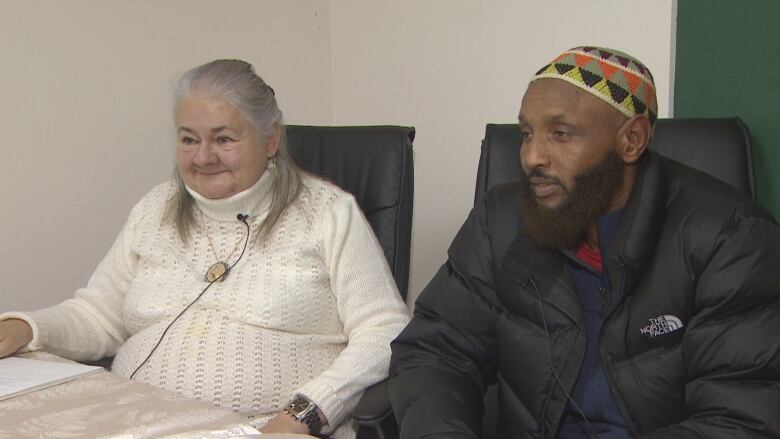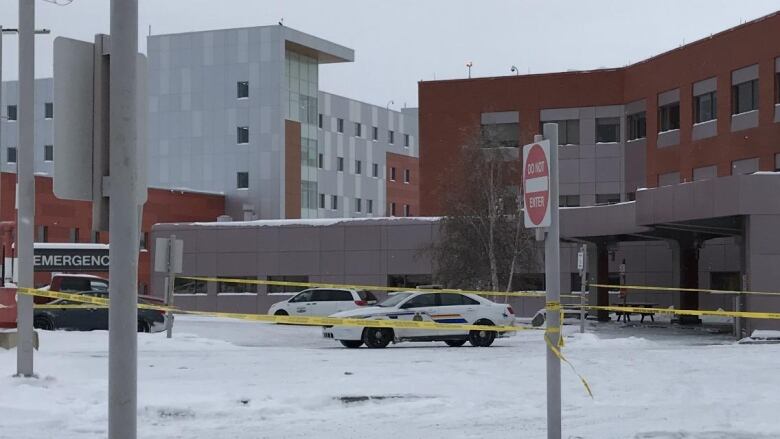In wake of Yellowknife taxi driver's death, fellow driver calls for added protections
From panic buttons to cameras, cab drivers in other Canadian cities have measures in place

A Yellowknife taxi driver, mourning the death of a co-worker this week, says the city must do more to protect drivers.
Nur Ali, who works for City Cab, says Yellowknife city council should change its bylaws to make it easier for taxi drivers to escape dangerous situations.
Specifically, Ali wants drivers to be exempt from having to wear a seatbelt.
"Someone sitting in a back seat, they can trap me [with] the seatbelt, they can choke me [with] the seatbelt," he said Wednesday.
"That's not safe."
Issues surrounding cab drivers' safety were thrust into the spotlight this week, afterAhmedMahamudAli was found unconscious in the back seat of the City Cab taxi he had beendriving early Monday morning. He was pronounced dead in hospital.
Two men have been charged with murder in connection with his death. They are scheduled to appear in court on Friday.
Nur Ali said he has driven taxis in Toronto and Los Angeles, and drivers in both cities can unbuckle their seatbelts when they feel they are at risk.

Cab drivers in Ontario don't have to wear a seatbelt while transporting a fare, but they must buckle up while driving alone. In Vancouver, taxi drivers can ride unbuckled at speeds under 70 km/h.
City Cab general manager Shirley McGrath said in Yellowknife, taxi drivers are required to wear seatbelts while driving.
Yellowknife Mayor Rebecca Alty says she has not yet had the chance to talk to taxi drivers, who are issued chauffeur's permits by the city.
"In regards to changing the bylaws for chauffeurs, that would be something we'd have to do with drivers," she said.
GPS, panic buttons and cameras
Nega Haile, president of Unifor Local 1688, which represents taxi drivers in Ottawa, recommends that drivers wear seatbelts. However, he understands why they may choose not to do so.
"At night, if you get into a kind of argument, you don't feel comfortable so you have to prepare yourself prepare to run away from the car," he said.
In Ottawa, said Haile, taxis have cameras, GPS and a hidden panic button near the driver's seat. When a driver hits the panic button, it sends a danger signal to the dispatcher, who can then call police and alert other taxis on the road.
"We always recommend to have those camera, panic button, GPS in the car installed," he said.
Ali said taxi drivers in Yellowknife can send an emergency signal to dispatch through thetablets installed in their vehicles, but some drivers are not aware of this capability.
Driving a cab is a dangerous job, said Ali.
"I had someone punch me on my eye and my eye was red [for] like a week," he said.

"I take a picture of myself and I show my kids and they start to cry when they saw that."
Ali is not the first taxi driver to say he has been punched while working. Another City Cab driver, Abdullah Ali, told CBCNews that getting assaulted on the job is not out of the ordinary.
Yellowknife drivers can install cameras
According to Statistics Canada data from 1997 to 2017, an average of 13 people die by homicide on the job each year.
Over this time period, taxi, truck and bus drivers comprised 15 per cent of work-related homicides. They closely followed police and correctional officers and security guards, whoaccounted for 19 per cent of homicides on the job.
"A taxi driver is not safe, in a sense, because he can be called at any place, by anybody with intentions which are not good, and he's alone," said Mohan Kang, president of the B.C. Taxi Association.

For this reason, said Kang, taxis in Metro Vancouver, the Victoria region and other B.C. communitiesare equipped with cameras.
Cameras won't protect drivers in the moment of an attack, said Kang, but they can act as a deterrent to potential assailants.
"They know that someone is watching that is the fear that they have, which is, in fact, correct," he said.
Cameras have also made it easier to secure convictions for customers who have assaulted drivers, Kang said.
City Cab drivers have the option of installing cameras in their vehicles at their own cost, said McGrath. All of the company's drivers are independent contractors, and each of the 82 vehicles is owned by a driver.
City Cab meters used to have panic buttons, but those went away when the company switched to new meters. It does not have a policy or specific protocols in place for how drivers should handle violent situations.
The Workers' Safety and Compensation Commission of Northwest Territories and Nunavut says it has received two medical reports from taxi drivers so far this year, but because neither driver had personal optional coverage, their claims were not accepted.
The commission encourages all workers to report workplace violence. They can do so anonymously online or by phone.
Ali, the City Cab driver, said he used to tell visitors that people in Yellowknife are nice and the city is safe.
"What to say now?" he said.
"The city has to do something."
- MORE NORTH NEWS |Yellowknife man sentenced to 3 years for assaulting prostitute, robbing cabbie at knifepoint
- MORE NORTH NEWS |Ash from Alaska volcano prompts aviation warning












_(720p).jpg)


 OFFICIAL HD MUSIC VIDEO.jpg)
.jpg)



























































































